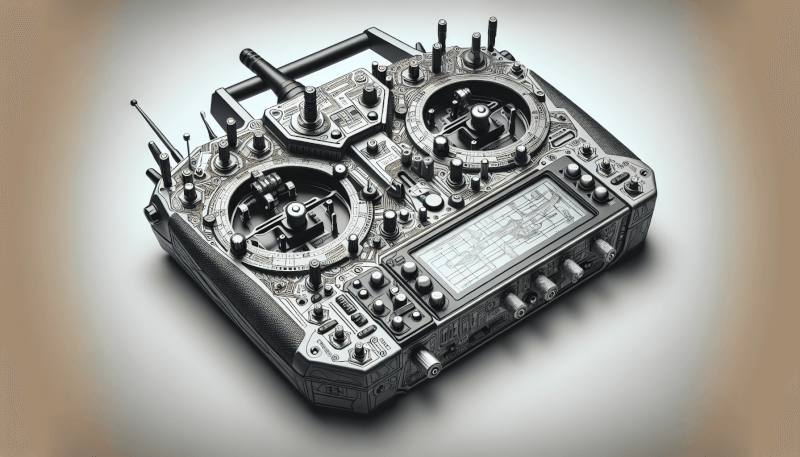Get ready to take your RC helicopter flying skills to the next level with our comprehensive guide on understanding RC heli transmitter settings. Whether you’re a seasoned pilot or just starting out, this article will provide you with all the information you need to know about transmitter settings and how they can enhance your flying experience. From throttle curves to dual rates, we’ll break down each setting in a friendly and easy-to-understand manner, ensuring that you have the confidence to make the necessary adjustments to your transmitter for optimal performance. So, grab your transmitter and let’s embark on this exciting journey of mastering RC heli transmitter settings!

What are RC Heli Transmitters?
Definition of RC Heli Transmitters
RC Heli transmitters, also known as radio controllers or transmitters, are devices used to control remotely operated helicopters, commonly referred to as RC helis. These transmitters transmit signals wirelessly to the RC heli, allowing you to operate and control its various functions, such as throttle, pitch, and maneuvering.
Importance of RC Heli Transmitters
RC heli transmitters play a crucial role in the operation and control of RC helicopters. They provide a direct link between the pilot and the helicopter, allowing for precise and accurate control. Without a dependable and properly functioning transmitter, it would be impossible to fly an RC heli safely and effectively.
Different Types of RC Heli Transmitters
Mode 1 Vs Mode 2
One important distinction among RC heli transmitters is the choice between Mode 1 and Mode 2. Mode 1 transmitters have the throttle control on the right stick, while Mode 2 transmitters have the throttle control on the left stick. The choice between these modes is largely a matter of personal preference, and pilots should choose the mode they feel most comfortable with.
2.4 GHz Vs 72 MHz
Another distinction lies in the frequency range of the RC heli transmitters. The most common frequencies used are 2.4 GHz and 72 MHz. 2.4 GHz transmitters have become the standard in recent years due to their superior range, reliability, and resistance to interference. On the other hand, 72 MHz transmitters have been used traditionally, but they are gradually being phased out due to limitations in range and susceptibility to interference.
Digital Vs Analog Transmitters
RC heli transmitters can also be categorized as either digital or analog. Digital transmitters offer more precise control and often come with advanced programming features. Analog transmitters, on the other hand, are simpler and generally more affordable. The choice between digital and analog transmitters mainly depends on the pilot’s skill level, budget, and desired features.
Understanding Channels and Frequencies
Number of Channels
Channels refer to the number of independent functions that can be controlled by the RC heli transmitter. Common transmitters range from 4 to 8 channels, with more advanced models offering even more channels. The number of channels you require largely depends on the complexity of your RC heli and the level of control you desire.
Frequency Bands and Control Range
Frequency bands determine the range at which the RC heli transmitter can effectively control the helicopter. 2.4 GHz transmitters generally offer a longer control range compared to 72 MHz transmitters. However, it is important to consider any local regulations regarding frequency bands to ensure compliance and avoid interference with other RC enthusiasts in the area.
Transmitter Features and Functions
Throttle Stick
The throttle stick is one of the most critical controls on an RC heli transmitter. It is used to control the rotational speed of the main rotor blades, determining the helicopter’s altitude and climb rate. By moving the throttle stick up or down, you can increase or decrease the engine power and adjust the height of your RC heli during flight.
Collective Pitch Control
Collective pitch control is another essential feature on an RC heli transmitter. Unlike airplanes that rely on a specific throttle setting, RC helicopters regulate their altitude by adjusting the collective pitch of the main rotor blades. By manipulating the collective pitch control on the transmitter, you can control the lift generated by the rotor blades and, consequently, control the helicopter’s altitude.
Swashplate Mixing
Swashplate mixing is a feature found in more advanced RC heli transmitters. It allows for control of the cyclic pitch, which controls the helicopter’s forward, backward, left, and right movements. Swashplate mixing enables simultaneous adjustments of the cyclic and collective pitch to achieve smooth and precise maneuvers during flight.
Throttle Hold
The throttle hold function is a safety feature found on many RC heli transmitters. It allows the pilot to momentarily cut off the engine’s fuel supply, reducing the throttle to zero. This feature can be useful in emergency situations or when performing certain maneuvers that require temporary suspension of engine power.
Idle Up
Idle up is a mode commonly used by advanced RC heli pilots. In this mode, the transmitter increases the rotor head speed, allowing for more agile and aerobatic maneuvers. Idle up mode is typically used during 3D flying or when performing advanced stunts that require increased rotor responsiveness.
Dual Rate/Expo
Dual rate and expo are features that allow the pilot to adjust the sensitivity and responsiveness of the RC heli’s controls. Dual rate adjusts the maximum movement range of the control sticks, while expo introduces nonlinear response, making the controls less sensitive around the center position. These features can be helpful for pilots at different skill levels or when flying in different weather conditions.
Trim adjustments
Trim adjustments are used to fine-tune the control surface positions of an RC heli. These adjustments compensate for any slight imbalances in the RC heli’s flight characteristics, ensuring stable and straight flight. By making small adjustments to the trim controls on the transmitter, you can achieve optimal flight performance and reduce the need for constant manual corrections during flight.

Setting up Transmitter Controls
Control Stick Configurations
RC heli transmitters offer various control stick configurations, allowing you to customize the layout to your preferences. The most common configuration is the Mode 2 setup, with the throttle on the left stick and the pitch and directional controls on the right stick. Some transmitters also offer adjustable stick tension or length to further personalize the control experience.
Transmitter Trims and Subtrims
Transmitter trims are used to adjust the neutral positions of the RC heli’s control surfaces without moving the mechanical linkages. By adjusting the trims, you can ensure that the helicopter stays level and stationary when the control sticks are at their neutral positions. Subtrim adjustments, on the other hand, allow for more precise centering of the control surfaces, eliminating any unwanted drift or deviation.
Adjusting Dual Rates and Expo
Dual rates and expo settings are adjustable features on the transmitter that affect the sensitivity and response of the RC heli’s controls. By adjusting these settings, you can fine-tune the control inputs based on your flying style, skill level, or environmental conditions. Experimenting with different dual rate and expo values allows you to find the optimal setup that suits your needs and enhances your flying experience.
Transmitter Modes and Switches
Flight Modes
Flight modes on an RC heli transmitter refer to different preset configurations with specific settings and functionalities. For example, a beginner flight mode can limit the helicopter’s performance to prevent accidents or mismanagement, while an advanced flight mode can unlock additional features and allow for more aggressive maneuvers. These modes are often controlled by switches on the transmitter, providing flexibility and versatility during flight.
Switch Configurations
RC heli transmitters feature switches that can be assigned to control various functions or settings. These switches allow for quick and convenient access to different flight modes, throttle cut, gyro gain adjustment, and other programmable features. By setting up the switch configurations to your preference, you can easily switch between different settings or activate specific functions during flight.

Transmitter Programming
Basic Programming Steps
Programming an RC heli transmitter involves customizing various settings and functions to suit your specific requirements. The basic steps include selecting the appropriate model memory, assigning channels to control specific functions, setting up servo directions, adjusting travel limits, and configuring mixes. The exact process may vary depending on the transmitter model, so it is important to refer to the manufacturer’s instructions for detailed programming guidance.
Model Memory and Presets
Transmitter model memory allows you to store different configurations for multiple RC helis in the same transmitter. This feature is particularly useful if you own and operate multiple helicopters with different setups. By utilizing the model memory and presets, you can easily switch between different helicopters without having to reconfigure the transmitter settings each time.
Advanced Programming Functions
Advanced RC heli transmitters often come with extensive programming capabilities. These functions allow for complex setups, such as custom mixes, flight mode sequencing, throttle curves, pitch curves, gyro gain adjustment, and more. Advanced programming functions offer greater control over the RC heli’s performance and allow experienced pilots to fine-tune their helicopters to their exact specifications.
Troubleshooting and Fine-tuning
Common Issues and Solutions
Although RC heli transmitters are reliable devices, occasional issues may arise during operation. Common issues include signal interference, control surface misalignment, trim adjustments, and failsafe settings. If you encounter any problems, it is best to consult the transmitter’s user manual or seek advice from experienced RC heli pilots to find the appropriate solutions.
Fine-tuning Transmitter Settings
Fine-tuning the transmitter settings is an ongoing process for RC heli pilots. As you gain experience and develop your flying skills, you may find the need to make subtle adjustments to the control settings to maximize performance. By carefully observing your RC heli’s flight behavior and experimenting with different settings, you can achieve precise control and optimize the flight characteristics to suit your flying style.

Safety Precautions
Importance of Safety Guidelines
When operating RC heli transmitters, it is crucial to follow safety guidelines to ensure the safety of yourself and others. Some key safety precautions include:
Familiarize yourself with the local regulations and guidelines regarding RC heli flying.
Always perform pre-flight checks to ensure the RC heli and transmitter are in proper working order.
Choose a suitable flying location, away from people, buildings, and other potential obstructions.
Keep a safe distance from power lines and other sources of electromagnetic interference.
Use a failsafe setting on your transmitter to reduce the risk of loss of control in the event of signal loss.
Pre-flight and Post-flight Checks
Before taking off, always conduct pre-flight checks to verify that all components are functioning correctly. This includes inspecting the RC heli for any damage or loose parts, checking the transmitter’s battery level, ensuring proper control surface movements, and confirming signal connection between the transmitter and the RC heli. Additionally, after each flight, perform post-flight checks to identify any issues that may have occurred during the flight and address them before your next flight.
Conclusion
Understanding and properly utilizing the settings and functions of an RC heli transmitter is crucial for safe and enjoyable flying. Whether you are a beginner or an experienced pilot, investing time in learning about the various features and settings will enhance your RC heli flying experience. By familiarizing yourself with the transmitter’s controls, programming options, and safety guidelines, you will be well-equipped to operate your RC heli with confidence and precision. Remember to always prioritize safety and enjoy the thrill and excitement of flying your RC helicopter.



